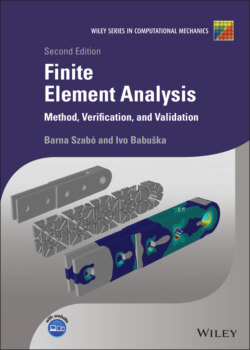Читать книгу Finite Element Analysis - Barna Szabó - Страница 31
1.3.5 Assembly
ОглавлениеHaving computed the coefficient matrices and right hand side vectors for each element, it is necessary to form the coefficient matrix and right hand side vector for the entire mesh. This process, called assembly, executes the summation in equations (1.62), (1.67) and (1.73). The local and global numbering of variables is reconciled in the assembly process. The algorithm is illustrated by the following example.
Example 1.6 Consider the three‐element mesh shown in Fig. 1.5. The polynomial degrees , , are assigned to elements 1, 2, 3 respectively. The basis functions shown in Fig. 1.5 are composed of the mapped Legendre shape functions. For instance, the basis function is composed of the mapped shape function N2 from element 1 and the mapped shape function N1 from element 2. This basis function is zero over element 3. Basis function is the mapped shape function N3 from element 3. This basis function is zero over elements 1 and 2.
Figure 1.5 Typical finite element basis functions in one dimension.
Table 1.1 Local and global numbering in Example 1.6.
| Element number | |||||||||
|---|---|---|---|---|---|---|---|---|---|
| Numbering | 1 | 2 | 3 | ||||||
| local | 1 | 2 | 3 | 1 | 2 | 1 | 2 | 3 | 4 |
| global | 1 | 2 | 5 | 2 | 3 | 3 | 4 | 6 | 7 |
Each basis function is assigned a unique number, called a global number, and this number is associated with those element numbers and the shape function numbers from which the basis function is composed. The global and local numbers in this example are indicated in Table 1.1.
We denote and, using equations (1.62) and (1.67), write in the following form:
where the elements within the brackets are in the local numbering system whereas the coefficients aj and bi outside of the brackets are in the global system. The superscripts indicate the element numbers. The terms multiplied by are summed to obtain the elements of the assembled coefficient matrix which will be denoted by . For example,
Assuming that the boundary conditions do not include Dirichlet conditions, the bilinear form can be written in terms of the coefficient matrix as:
(1.76)
The treatment of Dirichlet conditions will be discussed separately in the next section.
The assembly of the right hand side vector from the element‐level right hand side vectors is analogous to the procedure just described. Referring to eq. (1.73) we write in the following form:
where , , , etc.
